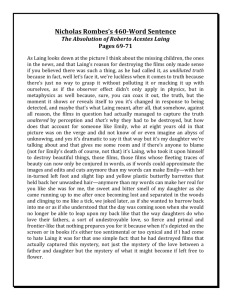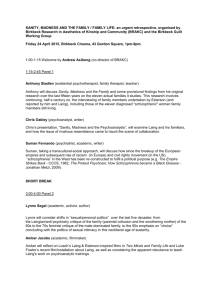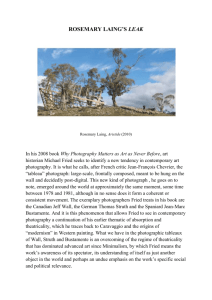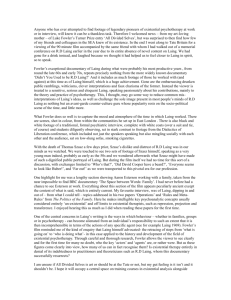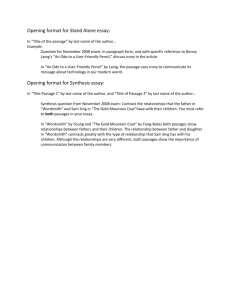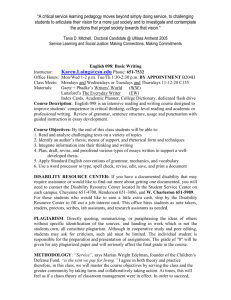The Sunday Times July 26, 2009 Sandra Laing: The outcast Sandra
advertisement
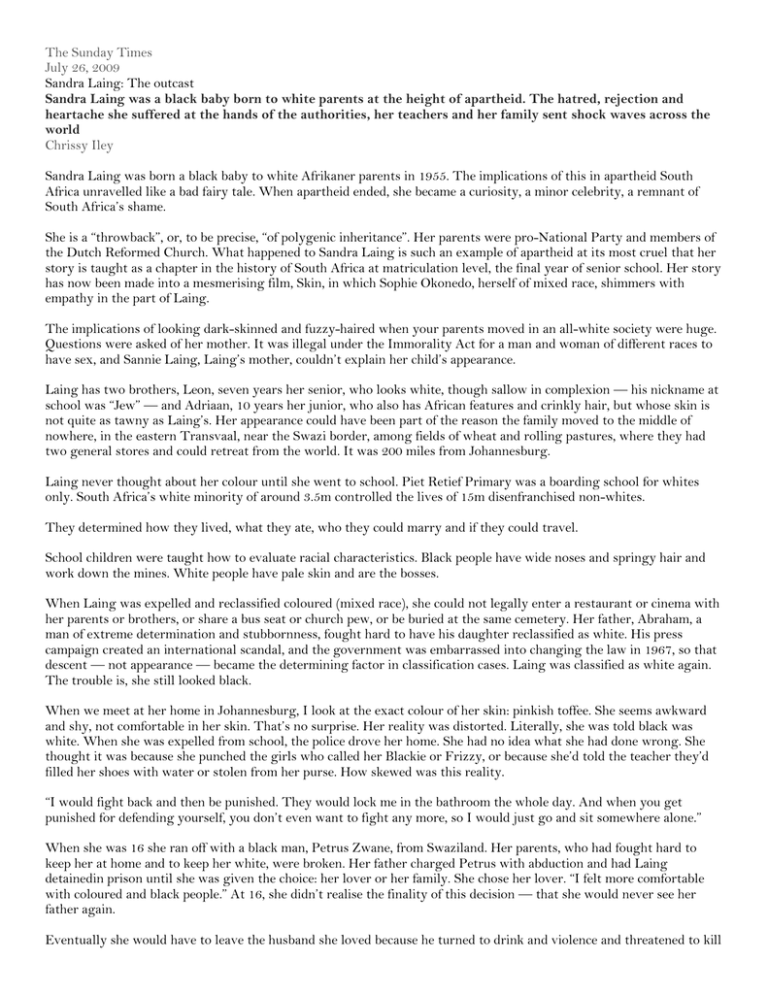
The Sunday Times July 26, 2009 Sandra Laing: The outcast Sandra Laing was a black baby born to white parents at the height of apartheid. The hatred, rejection and heartache she suffered at the hands of the authorities, her teachers and her family sent shock waves across the world Chrissy Iley Sandra Laing was born a black baby to white Afrikaner parents in 1955. The implications of this in apartheid South Africa unravelled like a bad fairy tale. When apartheid ended, she became a curiosity, a minor celebrity, a remnant of South Africa’s shame. She is a “throwback”, or, to be precise, “of polygenic inheritance”. Her parents were pro-National Party and members of the Dutch Reformed Church. What happened to Sandra Laing is such an example of apartheid at its most cruel that her story is taught as a chapter in the history of South Africa at matriculation level, the final year of senior school. Her story has now been made into a mesmerising film, Skin, in which Sophie Okonedo, herself of mixed race, shimmers with empathy in the part of Laing. The implications of looking dark-skinned and fuzzy-haired when your parents moved in an all-white society were huge. Questions were asked of her mother. It was illegal under the Immorality Act for a man and woman of different races to have sex, and Sannie Laing, Laing’s mother, couldn’t explain her child’s appearance. Laing has two brothers, Leon, seven years her senior, who looks white, though sallow in complexion — his nickname at school was “Jew” — and Adriaan, 10 years her junior, who also has African features and crinkly hair, but whose skin is not quite as tawny as Laing’s. Her appearance could have been part of the reason the family moved to the middle of nowhere, in the eastern Transvaal, near the Swazi border, among fields of wheat and rolling pastures, where they had two general stores and could retreat from the world. It was 200 miles from Johannesburg. Laing never thought about her colour until she went to school. Piet Retief Primary was a boarding school for whites only. South Africa’s white minority of around 3.5m controlled the lives of 15m disenfranchised non-whites. They determined how they lived, what they ate, who they could marry and if they could travel. School children were taught how to evaluate racial characteristics. Black people have wide noses and springy hair and work down the mines. White people have pale skin and are the bosses. When Laing was expelled and reclassified coloured (mixed race), she could not legally enter a restaurant or cinema with her parents or brothers, or share a bus seat or church pew, or be buried at the same cemetery. Her father, Abraham, a man of extreme determination and stubbornness, fought hard to have his daughter reclassified as white. His press campaign created an international scandal, and the government was embarrassed into changing the law in 1967, so that descent — not appearance — became the determining factor in classification cases. Laing was classified as white again. The trouble is, she still looked black. When we meet at her home in Johannesburg, I look at the exact colour of her skin: pinkish toffee. She seems awkward and shy, not comfortable in her skin. That’s no surprise. Her reality was distorted. Literally, she was told black was white. When she was expelled from school, the police drove her home. She had no idea what she had done wrong. She thought it was because she punched the girls who called her Blackie or Frizzy, or because she’d told the teacher they’d filled her shoes with water or stolen from her purse. How skewed was this reality. “I would fight back and then be punished. They would lock me in the bathroom the whole day. And when you get punished for defending yourself, you don’t even want to fight any more, so I would just go and sit somewhere alone.” When she was 16 she ran off with a black man, Petrus Zwane, from Swaziland. Her parents, who had fought hard to keep her at home and to keep her white, were broken. Her father charged Petrus with abduction and had Laing detainedin prison until she was given the choice: her lover or her family. She chose her lover. “I felt more comfortable with coloured and black people.” At 16, she didn’t realise the finality of this decision — that she would never see her father again. Eventually she would have to leave the husband she loved because he turned to drink and violence and threatened to kill her after their third baby died, saying she was a curse. Neither of her brothers will speak to her. She is now married to Johannes Motloung, and they live in a tiny bungalow in Boksburg, a lower-middle-class area of Johannesburg. After 27 years, she was able to reunite briefly with her mother after her father died. Their story was told in a Sunday Times Magazine Relative Values, which inspired the film director Anthony Fabian nine years ago. The movie took eight years to make. At the Pan African film festival in Los Angeles in January, there was not an audience member who was not undone by the end of it. Since then it has won four audience awards at film festivals, two jury prizes and a Time for Peace award. The story goes beyond race. It’s about a need to belong, a need to be loved and accepted. There’s a moment when her father lovingly puts skin-bleaching cream on her face to lighten her skin. It burns and he blows on it. Fabian describes Laing as like a peach. “The skin easily bruises, but there is a hard core, a big stone of strength.” Indeed, the woman I meet is a cocktail of timidity and ferocity. After years of having her reality questioned and being punished for it, she is careful. It is as if she has cauterised her emotions and separated herself from them. When I go to visit her, Laing, her daughter, Elsie, and her husband, Johannes, are in their tiny kitchen frying chicken for a party that Laing’s sons Henry, Prins, Anthony and Steve will attend. Steve is her youngest son. His father is Johannes, whose work in an engineering factory has been cut to two days a week. We are sitting on a worn biscuitcoloured sofa. On the wall there’s the Relative Values portrait: a frail white woman with sad eyes, her silver hair permed, being clasped by a large black woman. There is another picture of her mother as a young woman and Laing as a girl. These are the only things she has of her mother. They have been with her in every house she’s ever had, every place she’s ever fled. Laing’s mother died in 2001, a year after an intense reunion containing pain and love in equal amounts. And there’s another picture, of Laing at maybe 18, with two of her children. It’s the only picture in which her eyes and smile seem to belong to the same person. Happy moments have been scarce. Most of the time with me, she casts her eyes down. She finds it hard to look at anybody. The English she speaks is what she was taught at the convent she attended after being expelled from the boarding school. There were two years when she didn’t go to school at all. Afrikaans is her first language. She speaks Zulu with Johannes, and Swazi. I ask her if these days she thinks colour is a state of mind. “I don’t really know,” she says falteringly. Her springy curls are sheared short. “It was a long time before I would feel comfortable with myself. My mother would try to straighten my hair and the stuff burnt my scalp. When I got kicked out of school, nobody told me what I had done. My father was angry. I thought he just didn’t like me any more.” It’s a blur to her because she’s had to blot out so much of the horror of it. She can’t exactly say when or why she tried to lighten her skin. “I just thought I would take some bleach and wrap it round my arm, and it burnt me. I was around 11.” What colour did you see yourself? “I just didn’t know. I wasn’t happy to be taken from school. I was unhappy.” And this was the school in which she was tormented by other girls and wet her bed and vomited, which made them taunt her more. “I only started to feel differently when I met Petrus. That’s why I left home.” She says it like a plea, still wanting to be understood. Somebody’s skin colour is not the first thing you notice when you love them. Do you think your parents didn’t take in your colour? “I don’t know. There were lots of arguments.” Do you mean your father accused your mother of sleeping with a black man? “I think so. They went for a blood test to prove she did not.” How long was it before you felt comfortable within yourself? “That was at the time I met Petrus.” When she talks about Petrus she talks in definites and without faltering. “With Petrus I didn’t feel like an outsider.” He had been a vegetable vendor who supplied her parents’ store when she met him. After she ran off with him, there was no reasoning with her father and no going back. From Abraham Laing’s point of view, he’d fought hard in the climate of apartheid to secure his daughter’s future. But it was a warped form of love. After prison she went to live with Petrus’s family. His mother, Jenny, became a second mother to her and helped her with the birth of her first two babies. There were no hospitals available to Laing, who was neither black nor white. “I was very young to have a baby, 16. And the second one came very quickly. I was still playing with my friends. But Jenny helped me with the children. I was really happy.” She went in secret to visit her mother a few times so her children could meet their grandmother. “I was very angry with my father. Why did he send the police after me? He told my mother he never wanted to see me again and that if he found me he was going to kill me and then himself, so it was risky to see my mother.” Do you think he meant it? “I think so.” Did you ever tell them how unhappy you were, or about the bullying? “No.” Her parents moved to another town, traumatised by the scandal. She had no phone and no forwarding address for them. When Laing’s third baby, a daughter, died at only a few months old, Petrus was overcome with grief. He became violent and began hitting her. They had a little shop, and he started stealing the takings for drink. Then, in 1973, their town, Kromkrans, was declared a whites-only area. They were evicted. Laing was stripped of her home and her livelihood. Petrus threatened to kill her. She knew if she left him she would have to leave her children in care. She was still classified as white and legally not allowed to live with them. When she had tried to be reclassified as coloured, her father had refused to provide her birth certificate to help her. She could not legally work or open a bank account. She was a non-person who had been disowned by her family for a husband who was now trying to kill her. Laing was beyond desperate. She put her children into care so they would be fed, and began doing odd jobs; laundry, cleaning. She had another boyfriend. “But when he found out I was pregnant he started leaving me alone. I had bad luck with men. I was able to keep the baby, Anthony, with me because it was easier to look after a baby than an older child. I am so lucky Johannes is in my life. He does his best for me.” In 1984, her daughter Elsie, by Petrus, got sick, and Laing wanted Jenny’s help. She went to visit her and saw Petrus living with another woman. “I used to long for the old Petrus to come back, the one who was kind and loved me. He did ask me to come back, but I said I can’t come now, I have a new life. I loved Jenny very much, and I said I would bring the kids back for a holiday at Christmas. When I came back I found that Petrus had died. He’d been killed in a fight.” She sighs. “It was hard, but I’m happier now, much happier.” It’s hard to say how much the reunion with her mother, Sannie, contributed to this happiness, or caused more hurt. In the film, the reunion is beautiful. After 27 years she is accepted back and they love each other. You cry for what was lost and found. In real life, the tears are bittersweet, for what can never be reclaimed. After her father died, Laing was able to track her mother down with the help of a journalist from the South African Sunday Times. By this time Sannie was 80, had suffered several strokes and was in a nursing home. “They said, ‘Your daughter is here.’ She said, ‘What daughter?’ because Leon had told her that I had died. She couldn’t believe it was me. After she saw me the nurses told me, ‘She is much better for seeing you.’ She had been alone since my father died in 1998. “It was strange. I couldn’t believe this was my mother — so old and so sick. I had longed to see her for so many years. I had written several letters that had remained unanswered. I didn’t know where they had moved to and if they had been forwarded. She was there in her wheelchair and the feeling was a mixture of love and pain. I remember her as my mummy looking after me, cuddling me, showing me how the plants grew. I used to play with dolls. I had one called Melinda with long blonde hair, and we played with it together. And here she was, old. The mother-daughter relationship that we should have had seemed to have passed us by.” Did you ask her about your father and if he ever forgave you? “He left me some money in his will. It was the same he had left Adriaan and Leon. I think that was the forgiveness I’d been waiting for. She told me he had throat cancer and he was very ill. I didn’t ask anything else.” She begins to cry. “Leon told my mother I had died. He tried to pay me to not go and see her so he would not be caught out in lies. I didn’t ask my mother if my father had changed his mind about me because I couldn’t. I didn’t have the energy to fight any more or take any more rejection. He fought for me to have what he thought was a better life. But when I wouldn’t do it his way, he told my mother he would kill her if she had any contact with me. But I know he did love me. He went to court and did his best to keep me white because he thought that was best.” Does she feel as if her whole life she’d been running away from them or running to find them? “Yes, but I was running to find a better life. When I met Johannes I was working in the cosmetics factory near where he worked. I would see him on the bus to work. I thought, this is just another one that wants to play with me, but he proved to be different. He was a good man, and that has helped me a lot.” If Johannes has gone even part way to restore her faith in human nature, then that is a huge feat. Her children do that too. The one thing that haunts Laing is her relationship with her brothers. Neither of them speaks to her. When Adriaan was a baby she used to cradle him and feed him. “Leon told me that if Adriaan’s wife finds out that he has been talking to me she is going to divorce him.” Is it because Adriaan, himself quite dark-coloured, is ashamed of his even darker sister and the way it might interrupt his nice white life? “I don’t know what colour his children turned out to be. People say they are white. He must remember me, how close we were. Maybe he is scared of his wife.” Do you think it’s just about weakness, cowardice? “Yes. Leon was my big brother. He taught me to ride a bicycle. When my mother died they didn’t phone me. I phoned up to see how she was and they told me she’d died a week ago. I couldn’t even go to the funeral.” Does she feel her mother’s presence? “Yes, I feel she is looking after me. I feel her with me and I remember her as the person I left behind when I left home. And I don’t look back any more.” Is she afraid that the media attention over the film of her life will reopen old wounds? “No,” she says, with a really broad smile. “I am not afraid. I am ready for anything.” For the movie, Sophie Okonedo read the script before she met Laing. The director, Anthony Fabian, says: “Sophie, too, was brought up in an entirely white community and made to feel very aware of being different. She was rejected and teased. She had enormous empathy for what Sandra went through.” Sam Neill portrays Abraham as strict, stern and stubborn, but with huge love for his daughter. “It must have broken his heart,” says Fabian, “but he wasn’t able to come back from the position he took.” In the old South Africa, appearance was destiny. Even now racism doesn’t end. “In both America and the UK,” Fabian says, “people have said, we love your film, but you’ve got a problem: audiences are racist. In the case of the British distributor, they said, black people won’t see a film like this because it’s not designed for the urban audience; it’s not about black kids with guns, drugs and prostitutes. But we have won audience prizes at film festivals, which proves people don’t care what colour they are watching. They just care if they can be moved by the story.”
